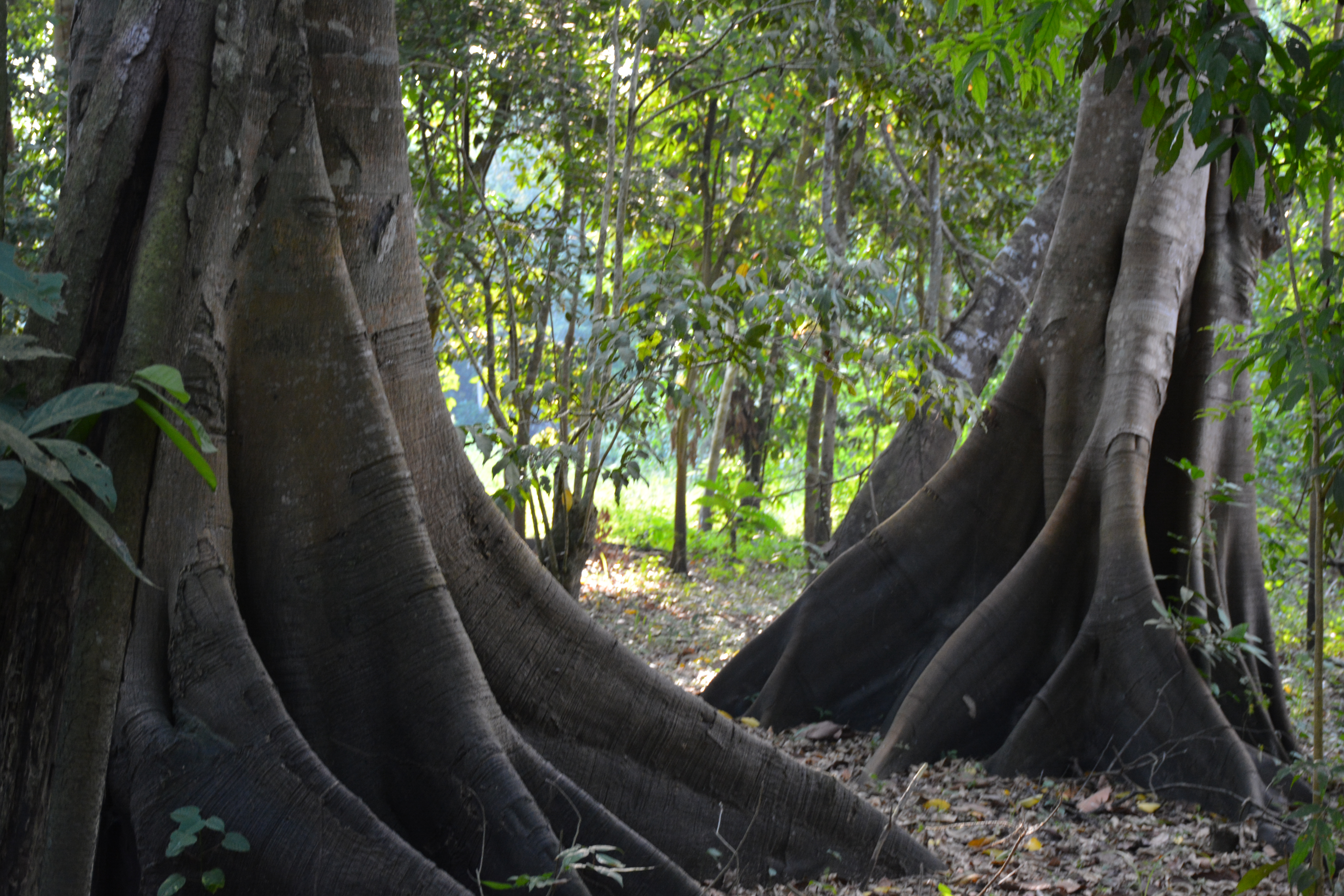The Forest-Shaman of Ucayali - Part 1
"You can't even imagine all that you will learn."
José Gama
I went into a café in Plaza de Armas in Pucallpa. The languid atmosphere contrasted with the glaring porcelain floor and the orange plastic tables. I ordered a café pasado which consists of a little cup of ristretto and another large one with hot water. The coffee is gradually poured into the water, that’s the way it is drunk. I felt it was muddy, as if I could chew it, possibly due to the dust that covered everything as a result of the lack of pavements. A fake shaman and a Swiss backpacker sat two tables away from me. The shaman was fake because he was wearing a feather headdress and a cushma, the backpacker was Swiss because he carried a bag covered with Swiss badges. The one who was not a shaman announced in English the cost of the ayahuasca ceremony; the backpacker's eyes shone. The shaman's eyes lit up too.
An elderly woman of Shipibo-Konibo ethnicity entered the café to sell crafts. Clearly exhausted, she sat down next to me, sharing my table. Her name was Mika. In spite of her age, she had brightly black hair. She shook a little maraca, a homemade rattle, and explained to me how it is used to sing the ícaros, the songs played in ayahuasca ceremonies. Then she started to sing. The waitress brought me a pineapple cake, and just as naturally as an Argentinean waiter would comment about the victory at the previous night’s soccer game, she told me how a tree with a bloody heart had shown up in her last ayahuasca journey to let her know that she should do a dieta de palo de sangre. Dieta means to go off to some isolated place for several days, with a shaman or master who provides you with traditional medicines from the jungle. Palo is the name given to the trees in this area. A dieta de palo consists of the ingestion of a decoction that comes from certain parts of a tree, that is consumed in some nook of the jungle over many days. While I was sharing my cake with Mika, my car arrived. I was going to Yarinacocha, a far-flung hamlet somewhere along the banks of a lagoon that carried the same name.
By mid-2016, I faced a little mystic crisis. I wondered: If I had the (good) karma of having been born in South America, then why did I spend the last dozen years devoted to Eastern espiritual practices? People would say that is a question shared by millions of Christians in America. But I am not referring to a tradition imposed during childhood; rather, to the choices we make as adults to hold on to some meditation practices, yoga, and Eastern thinking. Even though I didn’t lose sleep over it, the fact that I found an (apparent) contradiction in my life made me uncomfortable.
One night I had a surprisingly clear dream in which the anthropologist and shamanic practitioner Michael Harner prompted me to travel to Pucallpa to visit the Shipibo-Konibo indigenous peoples. I had never been to Pucallpa, and I barely knew about the Shipibo, except from what I had read in Harner's classic “Hallucinogens and Shamanism." I have to admit I still confused it with Escohotado’s “A Brief History of Drugs” as well as with Graves’s introduction to “The Greek Myths” where he wonders if the similarities between certain Aboriginal American and Greek mythology can find their source in the presence of the same kind of hallucinogenic mushroom that grows on both sides of the Atlantic.
Pucallpa (“May Ushin” in Shipibo) is the capital city of Ucayali Region, located in the Peruvian Amazon. It is also the cradle of ayahuasca. If something was clear at that time, it was that I did not feel the call to do ayahuasca. As yoga practitioners, we observe ancient precepts called yamas and niyamas, among which there is the principle of saucha which can be defined as keeping the body and mind in a state of purity. Undoubtedly, there is a large amount of yoga practitioners who alternate this discipline with ayahuasca ceremonies, as well as with alcohol, tobacco, drugs, or other substances, whether legal or not. It seems to be quite logical if we take into account that when we embrace an Eastern spiritual practice, we are forced to keep one foot in America and another in Asia. Indeed, I have had croissants with chyawanaprash for breakfast in Buenos Aires many times.
However, as we try to find the balance between America and Asia, we are met by the entire Greek system of thought, that is the way in which we have been taught to think in the Western world. I am referring particularly to the dialectic traps developed by the Sophists, contemporaries of Plato, who trained children of the Athenian élite to defend any argument, whether true or false, to achieve political and social success. The same happens to most of us with an honest spiritual practice: after so many centuries of hearing, arguing, and defending sophisms, we end up internalizing them, and they have become an automatic mechanism of reasoning.
Thus, with certain flexibility to reformulate the ancient yogic principles according to the current paradigm, some yoga practitioners combine yoga and ayahuasca ceremonies. Their logic is: It is true that we get intoxicated, but isn’t it sacred too? The Yoga Sutras' Book IV teaches about the siddhis or natural superpowers acquired “through incarnation; by drugs, sacred words, fervent desire, or meditation.” Drugs! Drugs! exclaim a legion of Western disciples. A heated argument began regarding the word “drugs” to decide if it should be translated from Sanskrit as “herbs.” Marijuana, marijuana! the same legion roars. I have no pretension or authority to talk about the interpretation of these concepts, I have just set out to list the arguments from both sides, which can be refuted and interpreted over and over again by virtue of our Greek masters.
As a matter of fact, perhaps backed up by the principles of saucha, I had eradicated ayahuasca as a possibility to appease my mystic concern. I was not willing to change my own belief system before I came across a better one. It was the hedgehog’s dilemma: If the keys to access South American ancestral knowledge were in the hands of intoxicating plants, then there was no answer to my existential concern.
Although my destiny was Pucallpa, quick research about the city and its possibilities for lodging left me perplexed; it is a noisy city, without any major attractions apart from its small Amazonian Port. Its modern architecture is not appealing and the accommodation not suitable for the spiritual quest. I expanded my search range and discovered that in the jungle there is a lagoon formed by the Ucayali river. It is called Yarinacocha, strictly speaking Yarina (cocha in Shipibo means lagoon) and it had a number of hamlets all around. Deep into the forest and by the lagoon there were some tambos for rent. A tambo is the place used to sleep over in the jungle during the dieta. It is kind of a bungalow with a floor and ceiling made of wood and plaited leaves, and some of the walls are made of mosquito netting fabric to be as close to the jungle as possible in case you are not brave enough to sleep outdoors, as in my case. These bungalows had the quality of having neither swimming pool nor TV. I had found my paradise. I took a shamanic journey with drums to reaffirm coordinates, and as usual the message was oracular: “The tree has already been cut." A week later I was flying to Perú.
“In every jungle that there are palos, there are maestros paleros,” José Gama told me once we were lying on the banks of Yarinacocha Lagoon at sunrise. A palero is the master who knows about tree medicine. Before starting his learning process to be a palero, José had already known about trees, thanks to his job as an explorer for wood companies. He used to stay long periods in the jungle, learning about plants, trees, and animals. “It’s good to walk through the jungle at night, the otorongo has followed me many times. I didn't get to see him but I could hear his footsteps, and he could hear mine.” He refers to the jaguar, the biggest feline living in America. “The palos harmonize bad energy. They wake up when we are disorganized. They are guardians. They take care of any negative issue you could come up with in your daily grind.”
But I had not yet met José when I arrived at Yarina late in the night. There were no lights; I could only catch a glimpse of the dense vegetation illuminated by the cars’ headlights. In the morning I was awakened by the roar of the motor boats that run the trade across the lagoon and the noise of the animals crying. I opened my eyes and I thought I had fallen down into the rabbit hole. In front of me I had the most majestic jungle, thick trees, lianas, and lush vegetation. Big colorful birds passed by in front of the mosquito net, which barely separated me from them. I could hear the noise of the dolphins splashing on the river. I rubbed my eyes, and when I opened them again, everything looked the same, but brighter.

Ph Leo Pinonsoy
